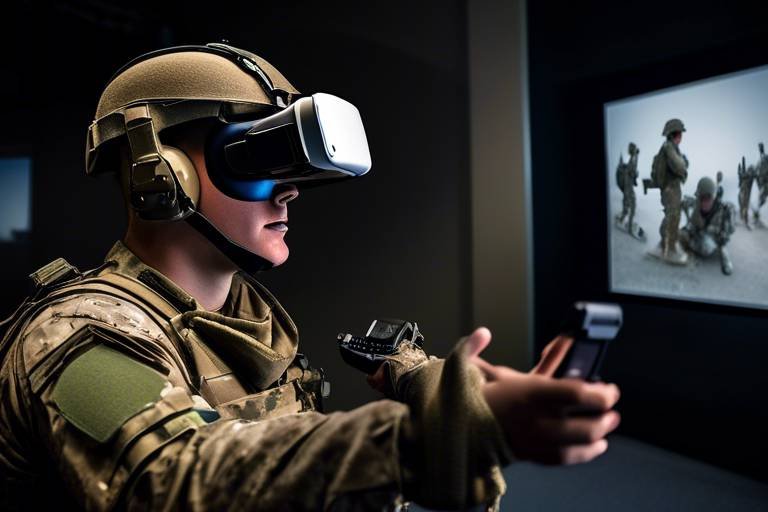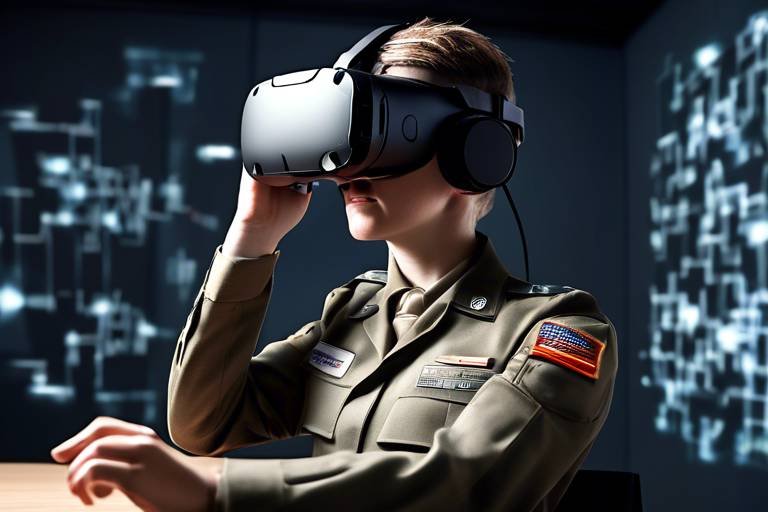Assessing VR Training for Multi-Domain Operations
This article explores the effectiveness of virtual reality (VR) training in preparing military personnel for multi-domain operations, examining its benefits, challenges, and future potential in modern warfare.
Virtual reality technology is transforming military training by providing immersive environments that simulate real-world scenarios, enabling personnel to practice critical skills without the risks associated with live training. Imagine stepping into a battlefield simulation where every sound, sight, and sensation feels real. This level of immersion allows soldiers to react instinctively, honing their skills in a controlled yet realistic setting. VR training not only enhances the learning experience but also prepares military personnel for the unpredictable nature of multi-domain operations, where success often hinges on quick thinking and adaptability.
VR training offers numerous advantages, including enhanced engagement, immediate feedback, and the ability to replicate complex scenarios, which can significantly improve learning outcomes and operational readiness for multi-domain operations. One of the standout features of VR is its ability to captivate attention. When soldiers are fully engaged, they absorb information more effectively. Furthermore, the immediate feedback provided by VR systems allows trainees to understand their mistakes in real-time, fostering a culture of continuous improvement. This instant correction mechanism is invaluable, especially in high-stakes environments where every second counts.
Investing in VR training can reduce costs associated with traditional training methods, such as travel and equipment, while providing a scalable solution that can be tailored to the needs of various military units. Consider the financial implications: traditional training often requires extensive travel to remote locations, specialized equipment, and sometimes even live munitions. With VR, these costs can be slashed dramatically. Training can occur anywhere, anytime, without the logistical nightmare of traditional setups.
The long-term savings from VR training can be substantial, as it minimizes wear and tear on physical equipment and reduces the need for extensive logistical support during training exercises. By utilizing VR, military organizations can extend the lifespan of their equipment and reduce the frequency of costly repairs. This not only saves money but also ensures that soldiers train with the best tools available, enhancing their readiness for real-world operations.
By utilizing VR, military organizations can allocate resources more efficiently, ensuring that personnel receive the training they need while optimizing overall operational budgets. Imagine a scenario where a unit can train together in a virtual environment without the constraints of physical location or resource limitations. This flexibility allows for better scheduling, improved training frequency, and ultimately, a more prepared force.
Despite its advantages, the implementation of VR training faces challenges, including technological limitations, resistance to change, and the need for comprehensive training programs for instructors and users alike. Not everyone is on board with the shift to VR. Some may be skeptical about its effectiveness, while others may struggle with the technology itself. Addressing these concerns is crucial for the successful adoption of VR training in military contexts.
Assessing the effectiveness of VR training requires robust metrics and evaluation methods to ensure that personnel are gaining the necessary skills and knowledge for successful multi-domain operations. It's not enough to simply implement VR training; military organizations must also track its impact. This involves setting clear objectives and measuring outcomes against those goals.
Incorporating feedback mechanisms within VR training can help identify areas for improvement, allowing for continuous refinement of training programs and ensuring they meet operational requirements. Regular assessments and feedback sessions can guide the development of training modules, ensuring they remain relevant and effective.
Conducting longitudinal studies on VR training outcomes can provide valuable insights into its long-term effectiveness and influence future training strategies within military organizations. By tracking performance over time, military leaders can make informed decisions about the continuation or expansion of VR training programs.
As technology continues to advance, the future of VR training in military operations looks promising, with potential developments that could further enhance training effectiveness and adaptability across various domains. Innovations in VR technology, such as improved graphics, haptic feedback, and AI-driven scenarios, are on the horizon. These advancements will create even more realistic training environments, preparing soldiers for the complexities of modern warfare.
- What is VR training?
VR training uses virtual reality technology to create immersive training environments that simulate real-world scenarios, allowing military personnel to practice critical skills safely.
- How does VR training benefit military personnel?
It enhances engagement, provides immediate feedback, and allows for the replication of complex scenarios, improving learning outcomes and operational readiness.
- What are the challenges of implementing VR training?
Challenges include technological limitations, resistance to change, and the need for comprehensive training programs for both instructors and users.
- How can the effectiveness of VR training be measured?
Effectiveness can be measured through robust metrics, feedback mechanisms, and longitudinal studies to track performance over time.

The Role of VR in Military Training
This article explores the effectiveness of virtual reality (VR) training in preparing military personnel for multi-domain operations, examining its benefits, challenges, and future potential in modern warfare.
Virtual reality technology is transforming military training by providing immersive environments that simulate real-world scenarios. Imagine stepping into a world where you can face the challenges of combat without the actual danger. VR allows military personnel to practice critical skills in a safe space, enabling them to hone their abilities without the risks associated with live training. This technology isn't just a flashy gimmick; it's a game-changer that enhances learning and prepares soldiers for the unpredictable nature of modern warfare.
One of the standout features of VR training is its ability to create realistic scenarios that can be tailored to specific operational needs. For example, soldiers can engage in simulated urban combat, aerial maneuvers, or even joint operations with allied forces, all designed to replicate the complexities of multi-domain operations. This level of customization ensures that training remains relevant and effective, addressing the unique challenges that personnel may face in various environments.
Moreover, VR training fosters a sense of engagement that traditional methods often lack. When soldiers are immersed in a virtual world, they are more likely to stay focused and absorb information. This heightened engagement translates to better retention of knowledge and skills, which is crucial when lives are on the line. The interactive nature of VR also allows for immediate feedback, enabling learners to understand their mistakes in real-time and adjust their strategies accordingly.
In addition to enhancing skill acquisition, VR training is also a powerful tool for team building. Soldiers can collaborate in virtual environments, practicing communication and coordination in ways that mirror real-life operations. This aspect is particularly important in multi-domain operations, where effective teamwork across different units and domains can mean the difference between success and failure. By working together in a virtual space, military personnel can develop camaraderie and trust, essential components for any successful mission.
Ultimately, the role of VR in military training is not just about technology; it's about revolutionizing the way we prepare our forces. By embracing this innovative approach, military organizations can ensure that their personnel are not only ready for the challenges of today but are also adaptable for the uncertainties of tomorrow. As we continue to explore the capabilities of VR, the potential for its application in military training seems limitless.
VR training offers numerous advantages, including enhanced engagement, immediate feedback, and the ability to replicate complex scenarios, which can significantly improve learning outcomes and operational readiness for multi-domain operations.
Investing in VR training can reduce costs associated with traditional training methods, such as travel and equipment, while providing a scalable solution that can be tailored to the needs of various military units.
The long-term savings from VR training can be substantial, as it minimizes wear and tear on physical equipment and reduces the need for extensive logistical support during training exercises.
By utilizing VR, military organizations can allocate resources more efficiently, ensuring that personnel receive the training they need while optimizing overall operational budgets.
Despite its advantages, the implementation of VR training faces challenges, including technological limitations, resistance to change, and the need for comprehensive training programs for instructors and users alike.
Assessing the effectiveness of VR training requires robust metrics and evaluation methods to ensure that personnel are gaining the necessary skills and knowledge for successful multi-domain operations.
Incorporating feedback mechanisms within VR training can help identify areas for improvement, allowing for continuous refinement of training programs and ensuring they meet operational requirements.
Conducting longitudinal studies on VR training outcomes can provide valuable insights into its long-term effectiveness and influence future training strategies within military organizations.
As technology continues to advance, the future of VR training in military operations looks promising, with potential developments that could further enhance training effectiveness and adaptability across various domains.
- What is VR training? VR training uses immersive technology to simulate real-world scenarios for military personnel, allowing them to practice skills safely.
- How does VR training improve engagement? The interactive nature of VR keeps soldiers focused and involved, leading to better retention of skills and knowledge.
- Are there any challenges in implementing VR training? Yes, challenges include technological limitations and resistance to change, which can hinder adoption.
- What are the long-term benefits of VR training? Long-term benefits include cost savings, reduced wear on equipment, and improved resource allocation.

Benefits of VR Training
Virtual Reality (VR) training is not just a passing trend; it’s a revolutionary approach that brings a plethora of benefits to military training. Imagine stepping into a fully immersive world where you can practice complex maneuvers without the fear of real-world consequences. This is precisely what VR training offers. By creating realistic scenarios, it allows military personnel to engage in training that closely resembles actual combat, enhancing their preparedness for multi-domain operations.
One of the most significant advantages of VR training is the enhanced engagement it provides. Traditional training methods often struggle to keep participants focused, leading to a lack of retention of crucial information. In contrast, VR captivates users with its interactive environments. When soldiers are placed in a virtual battlefield, their adrenaline kicks in, making them more invested in the training process. This level of engagement not only makes learning more enjoyable but also significantly boosts retention rates.
Another key benefit is the immediate feedback that VR training can provide. Unlike conventional methods where feedback might take days or weeks, VR systems can assess performance in real-time. For example, if a soldier makes a tactical error during a simulation, they can immediately receive corrective feedback, allowing them to adjust their strategy on the fly. This instant response creates a dynamic learning environment where mistakes can be turned into valuable lessons.
Moreover, VR training allows for the replication of complex scenarios that would be difficult or impossible to recreate in real life. Consider the challenges of training for a multi-domain operation that involves air, land, and cyber elements simultaneously. With VR, these scenarios can be seamlessly integrated, allowing personnel to practice coordination and strategy across various domains. This multifaceted training ensures that soldiers are well-prepared for the complexities of modern warfare.
To illustrate the advantages of VR training, let's take a look at a comparison of traditional training versus VR training:
| Aspect | Traditional Training | VR Training |
|---|---|---|
| Engagement Level | Moderate | High |
| Feedback Speed | Delayed | Immediate |
| Scenario Complexity | Limited | Unlimited |
| Cost | Higher (travel, equipment) | Lower (scalable) |
As we can see from the table, VR training not only enhances engagement and feedback but also provides a cost-effective solution that can adapt to various training needs. This adaptability is crucial for military units that require tailored training programs to meet specific operational demands.
In summary, the benefits of VR training are profound and multifaceted. From increased engagement and immediate feedback to the ability to replicate complex scenarios, VR is reshaping how military personnel prepare for multi-domain operations. As we continue to explore the potential of this technology, it’s clear that VR training is not just a tool; it’s a game-changer in the realm of military readiness.
- What is VR training? VR training uses virtual reality technology to create immersive training environments for military personnel.
- How does VR training improve engagement? By providing interactive and realistic scenarios, VR captures the user's attention and enhances focus.
- Is VR training cost-effective? Yes, it can reduce costs associated with traditional training methods, such as travel and equipment.
- Can VR training replicate complex scenarios? Absolutely! VR allows for the integration of multiple domains, making it ideal for comprehensive training.

Cost-Effectiveness of VR Solutions
When we talk about the cost-effectiveness of virtual reality (VR) solutions in military training, it's essential to recognize that this technology does more than just provide a flashy new way to train. It fundamentally changes how military personnel can prepare for complex scenarios without the hefty price tag of traditional methods. Imagine saving money while simultaneously enhancing training quality—sounds like a win-win, right?
One of the most significant advantages of VR training is its ability to minimize costs associated with traditional training methods. These methods often require extensive travel, specialized equipment, and a lot of logistical planning. VR, on the other hand, can be deployed in a controlled environment where personnel can train anytime and anywhere. This flexibility not only saves money but also time, allowing military units to focus on what really matters: honing their skills and operational readiness.
Moreover, the scalability of VR training solutions means that they can be tailored to fit the diverse needs of various military units. This adaptability ensures that resources are allocated efficiently, which is crucial in an era where budgets are often tight. For example, consider the following
| Traditional Training Costs | VR Training Costs |
|---|---|
| Travel Expenses | Minimal or None |
| Equipment Wear and Tear | Reduced |
| Logistical Support | Streamlined |
| Instructor Training | Integrated into VR Programs |
This table illustrates just how much VR training can cut costs in various areas. By reducing the need for physical resources and travel, military organizations can allocate their budgets more effectively. The result? More funds available for critical operations and personnel development.
In the long run, the savings from implementing VR training can be substantial. Not only does it minimize wear and tear on physical equipment, but it also reduces the logistical burden associated with traditional training exercises. Think about it: fewer vehicles on the road, less fuel consumed, and less wear on gear. All these factors contribute to a more sustainable training approach.
Additionally, the long-term savings can be reinvested into further advancements in training technology or improving other operational areas. This kind of resource allocation can be a game-changer for military organizations striving to maintain high levels of readiness while navigating budget constraints.
In conclusion, the cost-effectiveness of VR training solutions is evident. By embracing this innovative technology, military units can not only save money but also enhance their training capabilities. As we move forward, it will be exciting to see how VR continues to evolve and shape the future of military training.
- What are the main benefits of VR training for military personnel? VR training enhances engagement, provides immediate feedback, and allows for the replication of complex scenarios, improving learning outcomes.
- How does VR training reduce costs? It minimizes travel expenses, equipment wear and tear, and logistical support, leading to significant savings over time.
- Can VR training be customized for different military units? Yes, VR training solutions are scalable and can be tailored to meet the specific needs of various units.
- What challenges does VR training face? Technological limitations, resistance to change, and the need for comprehensive training programs for instructors and users are some of the challenges.

Long-Term Savings
The integration of virtual reality (VR) training into military operations is not just a trend; it's a strategic move that promises significant . Traditional training methods often involve extensive travel, the use of costly equipment, and the logistical challenges of coordinating large-scale exercises. In contrast, VR training allows personnel to engage in realistic scenarios without the associated costs of physical resources. Imagine a world where soldiers can practice complex maneuvers in a fully immersive environment from the comfort of their base—it's not just a dream, it's becoming a reality.
One of the most compelling aspects of VR training is its ability to minimize wear and tear on physical equipment. Traditional training exercises can lead to significant depreciation of vehicles, weapons, and other gear. With VR, these costs are drastically reduced. For example, consider a military unit that regularly conducts live-fire exercises. The expenses related to ammunition, maintenance, and potential damage to equipment can skyrocket. By shifting to a VR platform, these costs can be slashed, allowing funds to be redirected toward other critical areas.
Moreover, the savings extend beyond direct costs. The logistical support required for traditional training exercises can be overwhelming. Deploying personnel, arranging transportation, and ensuring that all necessary equipment is available can consume vast amounts of time and resources. VR training eliminates many of these logistical hurdles, allowing military organizations to allocate their resources more efficiently. This means that units can focus more on honing their skills rather than getting bogged down in the logistics of training.
To illustrate the potential savings, consider the following table that compares the estimated costs of traditional training versus VR training:
| Training Method | Estimated Cost per Session | Logistical Support Required |
|---|---|---|
| Traditional Training | $10,000 | High |
| VR Training | $2,500 | Low |
As shown in the table, the cost per session for VR training is significantly lower than that of traditional training methods. This not only highlights the immediate financial benefits but also underscores the potential for long-term fiscal responsibility within military budgets. The ability to conduct high-quality training sessions at a fraction of the cost means that military organizations can invest in other vital areas, such as technology upgrades or personnel development.
In conclusion, the long-term savings associated with VR training are not just about cutting costs; they represent a shift in how military organizations can operate more efficiently and effectively. By embracing this innovative approach, the military can enhance its training programs while ensuring that resources are allocated where they are needed most. The future of military training is here, and it's time to take advantage of the numerous benefits that VR has to offer.
- What are the main benefits of VR training in the military?
VR training provides immersive environments, reduces risks associated with live training, and enhances engagement and learning outcomes. - How does VR training save costs?
It minimizes wear and tear on physical equipment, reduces travel expenses, and lowers logistical support requirements. - What challenges are associated with implementing VR training?
Challenges include technological limitations, resistance to change, and the need for comprehensive training programs for instructors. - How can the effectiveness of VR training be measured?
Effectiveness can be assessed through robust metrics, feedback mechanisms, and longitudinal studies on training outcomes.

Resource Allocation
In the realm of military operations, is a critical factor that can determine the success or failure of missions. With the advent of virtual reality (VR) training, military organizations now have a powerful tool at their disposal to optimize how they deploy their resources. VR training not only allows for realistic simulations but also significantly reduces the costs associated with traditional training methods. Imagine being able to practice complex maneuvers in a safe, controlled environment without the need for extensive physical setups or travel. This is where VR shines.
By integrating VR into their training regimens, military units can allocate their resources more efficiently. For instance, instead of spending large sums on fuel and transport for live exercises, units can conduct training sessions virtually. This frees up funds that can be redirected towards enhancing technology, improving facilities, or even investing in personnel development. Furthermore, VR training can be tailored to the specific needs of different units, ensuring that each team receives the precise training they require without unnecessary expenditure.
Another aspect of resource allocation is the potential for scalability. VR training programs can easily be scaled up or down depending on the size of the unit or the complexity of the training required. This flexibility means that resources can be dynamically adjusted to meet the immediate needs of the military, rather than being locked into a rigid training schedule that may not be effective for all personnel. The ability to create a wide range of training scenarios in a virtual environment makes it possible to prepare for various operational contexts without the logistical headaches typically associated with live training.
Moreover, VR training minimizes wear and tear on physical equipment, which is a substantial cost-saving factor. Traditional training often involves the use of expensive machinery and weaponry that require maintenance and replacement. With VR, much of this wear and tear is eliminated, allowing military organizations to preserve their physical assets while still delivering high-quality training. This not only leads to long-term savings but also ensures that equipment remains ready for actual deployment when needed.
In conclusion, the effective allocation of resources through the implementation of VR training can lead to a more agile, efficient, and cost-effective military operation. By embracing this innovative technology, military organizations can ensure that they are not only preparing their personnel for the complexities of modern warfare but also doing so in a way that maximizes the use of their available resources.
- What is VR training? VR training uses immersive virtual environments to simulate real-world scenarios for military personnel.
- How does VR training improve resource allocation? It reduces costs related to travel and equipment, allowing for more efficient use of military resources.
- Can VR training be tailored for different military units? Yes, VR training can be customized to meet the specific needs of various military units.
- What are the long-term benefits of using VR in military training? Long-term benefits include cost savings, reduced equipment wear, and improved operational readiness.

Challenges in Implementing VR Training
While the potential of Virtual Reality (VR) training in military applications is immense, it is not without its challenges. One of the most significant hurdles is the technological limitations that can hinder the deployment and effectiveness of VR systems. For instance, not all military installations have access to the latest hardware or software, which can lead to inconsistencies in training experiences. Imagine trying to run a marathon in a pair of shoes that don’t fit properly; that’s what it feels like when personnel are forced to train on outdated VR systems.
Another challenge is resistance to change. Military personnel are accustomed to traditional training methods, and shifting to a VR-based approach can be met with skepticism. Some may question the realism of virtual environments compared to real-life scenarios. This skepticism can create a barrier to effective training. It’s like trying to convince someone that a virtual roller coaster can be just as thrilling as the real thing; until they experience it, they might not believe it.
Moreover, the successful implementation of VR training requires comprehensive training programs for both instructors and users. Without proper training on how to use the VR systems effectively, the potential benefits can be lost. Instructors must not only understand the technology but also how to integrate it into existing training frameworks. This is akin to a chef needing to master a new cooking technique before serving a gourmet meal; without that expertise, the results may fall short.
Additionally, there are considerations regarding cost and resource allocation. While VR training can be cost-effective in the long run, the initial investment can be daunting. Military organizations often operate under tight budgets, and allocating funds for new technology can be a tough sell. It’s crucial for decision-makers to see the long-term benefits that VR can bring, which requires a well-articulated plan and demonstration of potential return on investment.
Lastly, there’s the challenge of ensuring that VR training is aligned with operational needs. The scenarios created in VR must accurately reflect the complexities of multi-domain operations. If the training does not match real-world requirements, it could lead to a gap in skills when personnel are deployed. This alignment is critical, as effective training should prepare soldiers for the unpredictable nature of modern warfare, much like a pilot practicing in a simulator that replicates the exact conditions they will face in the sky.
In summary, while VR training holds great promise, overcoming these challenges is essential for its successful implementation. By addressing technological limitations, fostering a culture of acceptance, providing comprehensive training, managing costs effectively, and ensuring alignment with operational needs, military organizations can harness the full potential of VR technology.
- What are the main benefits of VR training in military operations?
VR training enhances engagement, provides immediate feedback, and allows for the replication of complex scenarios, making it a valuable tool for improving operational readiness.
- Are there any risks associated with VR training?
While VR training is generally safe, there can be risks related to technological failures or inadequate training on the systems, which could lead to ineffective learning experiences.
- How can military organizations overcome resistance to VR training?
By demonstrating the effectiveness of VR through pilot programs and showcasing its benefits, military organizations can gradually foster acceptance among personnel.
- What is the cost comparison between traditional and VR training?
While the initial investment in VR technology can be high, it often leads to long-term savings by reducing costs associated with travel, equipment wear and tear, and logistical support.

Measuring Training Effectiveness
When it comes to military training, especially in the realm of virtual reality (VR), measuring effectiveness is not just a checkbox on a list; it's a critical component that can make or break the success of a training program. After all, how do you know if your personnel are truly prepared for the complexities of multi-domain operations? This is where robust metrics and evaluation methods come into play. By employing a combination of qualitative and quantitative assessments, military organizations can gain a clear picture of how well their VR training programs are performing.
One effective way to measure training effectiveness is through the use of feedback mechanisms. Incorporating real-time feedback during VR training sessions can help identify specific areas where trainees may struggle. For instance, if a soldier consistently fails to navigate a simulated battlefield scenario, immediate feedback can guide them to understand their mistakes and improve. This not only enhances the learning experience but also ensures that personnel are gaining the necessary skills to operate effectively in real-world situations.
Moreover, the integration of longitudinal studies is essential for understanding the long-term impact of VR training. These studies can track the performance of military personnel over time, providing valuable insights into how well they retain skills learned during VR training. For example, if soldiers participate in a VR training program and are later assessed on their operational readiness months down the line, it can reveal whether the training was effective in the long run. Such data is invaluable for refining training strategies and ensuring that resources are allocated efficiently.
In addition to feedback mechanisms and longitudinal studies, it's also important to consider a variety of evaluation metrics. Some of these may include:
- Skill retention rates
- Response times in simulated scenarios
- Success rates in mission objectives
- Trainee satisfaction and engagement levels
By analyzing these metrics, military organizations can make informed decisions about their training programs. For instance, if data shows that response times improve significantly after VR training, it indicates that the program is effectively preparing personnel for high-pressure situations. On the other hand, if satisfaction levels are low, it might be time to rethink the training approach.
Ultimately, measuring training effectiveness in VR is not just about collecting data; it's about using that data to create a cycle of continuous improvement. By regularly assessing training outcomes and making necessary adjustments, military organizations can ensure that their personnel are not only prepared but excel in multi-domain operations. In a world where the stakes are high, this level of preparedness can make all the difference.

Feedback Mechanisms
In the realm of virtual reality training, play a crucial role in enhancing the learning experience for military personnel. Imagine stepping into a VR simulation where every move you make is tracked, analyzed, and critiqued in real-time. This is not just a futuristic dream; it’s the reality of modern military training that leverages technology to provide immediate insights into performance. The ability to receive instant feedback allows trainees to correct mistakes on the spot, leading to a more effective and engaging learning process.
One of the most effective feedback mechanisms incorporates analytics and performance metrics. By using sophisticated tracking software, military trainers can monitor various parameters, such as decision-making speed, accuracy, and adherence to protocol. This data can be presented in a user-friendly format, often through dashboards that highlight key performance indicators (KPIs). For example, a trainee might receive a score based on their response time during a simulated combat scenario, alongside suggestions for improvement. This immediate feedback loop not only boosts confidence but also fosters a culture of continuous learning.
Furthermore, incorporating peer reviews can add an additional layer of feedback. When trainees have the opportunity to assess each other's performance, they gain different perspectives that can enhance their understanding of the material. This collaborative environment encourages open dialogue about strategies and techniques, making learning more dynamic and less isolated. For instance, after a simulation, trainees could engage in a debriefing session, discussing what went well and what could be improved. This peer feedback can be as valuable as instructor-led critiques, offering a well-rounded approach to skill development.
Additionally, surveys and questionnaires can be utilized to gather qualitative feedback from participants post-training. Questions may range from the realism of the scenarios to the effectiveness of the training tools used. By analyzing this feedback, military organizations can refine VR programs to better meet the specific needs of their personnel. This iterative process ensures that training remains relevant and effective in preparing soldiers for the complexities of multi-domain operations.
In conclusion, feedback mechanisms are not just an add-on; they are integral to the success of VR training in military contexts. By leveraging technology to provide real-time analytics, promoting peer reviews, and soliciting participant feedback, military organizations can create a robust training environment that continually evolves and improves. This not only enhances individual performance but also strengthens the overall operational readiness of military units.
- What are the main benefits of using VR for military training?
VR provides immersive environments, immediate feedback, and the ability to replicate complex scenarios, significantly improving learning outcomes. - How does feedback in VR training differ from traditional training?
Feedback in VR is instantaneous and often data-driven, allowing for immediate corrections, while traditional training may rely on delayed assessments. - Can VR training be customized for different military units?
Yes, VR training programs can be tailored to meet the specific needs and objectives of various military units, enhancing relevance and effectiveness. - What challenges might arise when implementing VR training?
Challenges include technological limitations, resistance to change, and the need for comprehensive training for instructors and users.

Longitudinal Studies
Longitudinal studies play a crucial role in assessing the effectiveness of virtual reality (VR) training within military contexts. These studies involve repeated observations of the same variables over long periods, allowing researchers and military strategists to track changes and improvements in skills and knowledge retention among personnel. Imagine trying to measure the growth of a tree: a single snapshot might not tell you much, but watching it grow over the years reveals its health and resilience. Similarly, longitudinal studies provide a comprehensive view of how effective VR training is over time.
One of the significant advantages of conducting longitudinal studies in VR training is the ability to analyze data that reflects real-world applications. For instance, by observing a cohort of soldiers who have undergone VR training, researchers can evaluate their performance in actual multi-domain operations compared to those who received traditional training. This comparison can highlight not only the immediate benefits of VR training but also its long-term impact on operational readiness.
Moreover, longitudinal studies can help identify trends and patterns in training effectiveness. By gathering data at various intervals, military organizations can assess whether skills learned in a VR environment translate effectively to real-life scenarios. This process often involves collecting qualitative and quantitative data, such as:
- Performance metrics during training exercises
- Feedback from participants regarding their confidence and preparedness
- Operational outcomes during missions post-training
To illustrate the potential of longitudinal studies, consider a hypothetical research project focusing on a specific VR training program designed for drone operations. Over three years, researchers could track a group of trainees, measuring their proficiency with drones at regular intervals. The results might reveal that those who trained using VR not only performed better during simulations but also had a higher success rate in real-world missions, thereby justifying the investment in VR technology.
Additionally, the insights gained from these studies can inform future training strategies. If a particular aspect of VR training is found to be less effective, military organizations can adjust their programs accordingly. This adaptability is vital in a rapidly changing technological landscape, ensuring that training remains relevant and effective.
In conclusion, longitudinal studies are essential for understanding the lasting effects of VR training in military operations. They provide a detailed narrative of growth and effectiveness, enabling military personnel to refine their training approaches continually. By focusing on the long-term outcomes of VR training, military organizations can ensure they are not only preparing their personnel for today’s challenges but also equipping them for the unpredictable nature of future warfare.
- What are longitudinal studies? Longitudinal studies involve repeated observations of the same variables over an extended period, allowing researchers to track changes and developments.
- How do longitudinal studies benefit military training? They provide insights into the long-term effectiveness of training programs, helping organizations refine their methods and improve operational readiness.
- Can VR training be measured effectively? Yes, through longitudinal studies, performance metrics, and participant feedback can be analyzed to assess the effectiveness of VR training.
- What types of data are collected in these studies? Data may include performance metrics, trainee feedback, and operational outcomes during missions post-training.

The Future of VR in Military Operations
The horizon of military training is rapidly evolving, and at the forefront of this transformation is virtual reality (VR). As we look ahead, the future of VR in military operations is not just about enhancing training; it's about redefining how we prepare our forces for the complexities of modern warfare. Imagine a world where soldiers can engage in realistic combat scenarios without ever leaving their base, honing their skills in a safe yet challenging environment. This is not science fiction—it's the potential that VR holds for military training.
With advancements in technology, we can expect VR training to become even more immersive and interactive. Future developments may include haptic feedback systems that allow users to feel the environment around them, making simulations more lifelike. For instance, a soldier could feel the impact of a simulated explosion or the recoil of a weapon, providing a deeper understanding of combat situations. This level of realism can significantly enhance the learning experience, preparing personnel for the unpredictable nature of multi-domain operations.
Moreover, the integration of artificial intelligence (AI) into VR training programs can further personalize the learning experience. AI-driven simulations can adapt in real-time based on a soldier's performance, presenting new challenges that push the boundaries of their skills. This means that each training session can be unique, tailored to the individual’s progress, and focused on areas that require improvement. Such dynamic training environments can lead to higher retention rates of knowledge and skills, ultimately contributing to mission success.
Another exciting aspect of the future of VR in military operations is the potential for collaborative training. Soldiers from different units or even allied forces could engage in joint training exercises through VR platforms, breaking down barriers and fostering teamwork. Picture this: troops from various countries working together in a virtual battlefield, strategizing and executing missions as a cohesive unit. This not only builds camaraderie but also prepares forces for real-world coalition operations.
However, despite the promising future, there are challenges that need to be addressed. The initial investment in VR technology can be substantial, and military organizations must weigh the costs against the potential benefits. Furthermore, ensuring that all personnel are adequately trained to use these systems is crucial. A well-implemented training program will be essential to maximize the effectiveness of VR training and ensure that it is seamlessly integrated into existing military curricula.
In conclusion, the future of VR in military operations is bright and full of potential. As technology continues to evolve, so too will the capabilities of VR training programs. By embracing these advancements, military organizations can prepare their personnel for the complexities of modern warfare, ensuring they are ready for any challenge that lies ahead. The question is not whether VR will play a role in the future of military training, but rather how quickly we can adapt and leverage this technology for operational excellence.
- What is VR training in the military?
VR training in the military refers to the use of virtual reality technology to simulate real-world combat scenarios, allowing personnel to practice critical skills in a safe environment.
- How does VR training enhance operational readiness?
By providing immersive and interactive training experiences, VR helps soldiers develop skills more effectively, leading to improved performance in actual operations.
- What are the cost implications of implementing VR training?
While the initial investment in VR technology can be high, it can lead to long-term savings by reducing costs associated with traditional training methods.
- Can VR training be used for joint operations with allied forces?
Yes, VR training can facilitate collaborative exercises between troops from different countries, enhancing teamwork and preparedness for coalition operations.
Frequently Asked Questions
- What is VR training in military operations?
VR training in military operations refers to the use of virtual reality technology to create immersive training environments that simulate real-world scenarios. This allows military personnel to practice critical skills in a safe, controlled setting, enhancing their readiness for multi-domain operations.
- What are the main benefits of VR training?
Some key benefits of VR training include enhanced engagement, immediate feedback, and the ability to replicate complex scenarios. These factors significantly improve learning outcomes and operational readiness, making VR a valuable tool for military training.
- How does VR training save costs?
Investing in VR training can lead to substantial cost savings by reducing expenses related to traditional training methods, such as travel and equipment. Additionally, VR provides a scalable solution that can be tailored to the specific needs of various military units, optimizing resource allocation.
- What challenges does VR training face?
Despite its advantages, VR training implementation can encounter challenges such as technological limitations, resistance to change from personnel, and the necessity for comprehensive training programs for both instructors and users to ensure effective use of the technology.
- How is the effectiveness of VR training measured?
Measuring the effectiveness of VR training involves using robust metrics and evaluation methods to assess whether personnel are acquiring the necessary skills and knowledge for successful multi-domain operations. Incorporating feedback mechanisms and conducting longitudinal studies can provide valuable insights for continuous improvement.
- What does the future hold for VR in military training?
The future of VR in military training looks promising, with ongoing technological advancements that could further enhance training effectiveness and adaptability across various operational domains. As these technologies evolve, they are expected to play an increasingly vital role in military preparedness.



















